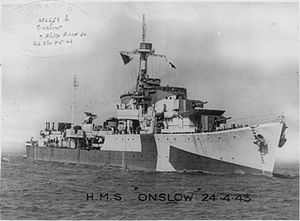HMS Onslow (G17)
 Onslow in 1943
| |
| History | |
|---|---|
| Name | HMS Onslow |
| Ordered | 3 September 1939 |
| Builder | John Brown & Company, Clydebank |
| Cost | £416,942 |
| Laid down | 1 July 1940 |
| Launched | 31 March 1941 |
| Commissioned | 8 October 1941 |
| Decommissioned | April 1947 |
| Motto |
|
| Honours and awards |
|
| Fate | Transferred to Pakistan, 1949 |
| Badge | On a field white an eagle black preying on an anchor gold |
| Name | PNS Tippu Sultan |
| Namesake | Tippu Sultan |
| Commissioned | 1949 |
| Decommissioned | 1979 |
| Out of service | 1957 |
| Reinstated | 1960 |
| Homeport | Karachi |
| Fate | Scrapped, 1980 |
| General characteristics | |
| Class and type | O-class destroyer flotilla leader |
| Displacement | 1,550 long tons (1,570 t) |
| Length | 345 ft (105 m) o/a |
| Beam | 35 ft (11 m) |
| Draught | 13 ft 6 in (4.11 m) |
| Propulsion |
|
| Speed | 37 knots (43 mph; 69 km/h) |
| Range | 3,850 nmi (7,130 km) at 20 kn (23 mph; 37 km/h) |
| Endurance | 472 tons oil |
| Complement | 176+ |
| Armament |
|
| Service record | |
| Part of: | Home Fleet |
| Commanders: | Captain Robert Sherbrooke |
| Operations: |
|
HMS Onslow was an O-class destroyer flotilla leader of the Royal Navy She was ordered from John Brown & Company at Clydebank, Glasgow on 3 September 1939. The ship was laid down on 1 July 1940 and launched on 31 March 1941. She was completed on 8 October 1941 at a cost of £416,942.[1]
Service history
Attached to the Home Fleet, Onslow served mostly as an escort to Arctic convoys. She also saw detached service in the Mediterranean during "Operation Harpoon" in 1942, and in the English Channel before and after the Normandy landings in mid-1944. Her most notable action was at the Battle of the Barents Sea in 1942, while escorting Convoy JW 51B to Russia. The convoy escorts held off attacks from the powerful Admiral Hipper, with Onslow being heavily damaged and her captain, Robert Sherbrooke, severely injured.
In November 1945 she was the headquarter ship for Operation Deadlight, helping move U-boats from Loch Ryan for scuttling off Bloody Foreland. She returned to the reserve at Devonport in 1947. In August 1947 she was a submarine target ship and anti-submarine trials ship at Portsmouth.[2]
Decommissioned in October 1947, the ship was procured by the Pakistan Navy in 1949 and commissioned as PNS Tippu Sultan.[3] In 1954 she underwent a refit at Malta. Between 1957 and 1959 she underwent conversion to a Type 16 frigate at Birkenhead.[4] She served in the Pakistan Navy until 1979.
See also
Notes
- ^ Critchley, Mike, "British Warships Since 1945: Part 3: Destroyers", Maritime Books: Liskeard, UK, 1982. ISBN 0-9506323-9-2, page 14
- ^ In fact she remained HMS Tippu Sultan for some years, prior to renaming later in 1952-53. See documents and photograph of Mr A.Salim Khan, Pakistan's First Charge d'Affaires to Japan, and his voyage on this ship from the United States to Yokohama, in the Begum Mahmooda Salim Khan Collection/Papers, Accession Ref.No. 224-BMS, at the National Archives of Pakistan, Islamabad, website for further information http://www.nap.gov.pk
- ^ Blackman, Raymond V B, Jane's Fighting Ships 1963-4, Sampson Low, Marston & Co. Ltd, London, p195
References
- Colledge, J. J.; Warlow, Ben (2006) [1969]. Ships of the Royal Navy: The Complete Record of all Fighting Ships of the Royal Navy (Rev. ed.). London: Chatham Publishing. ISBN 978-1-86176-281-8.
- Connell, G. G. (1982). Arctic Destroyers: The 17th Flotilla. London: William Kimber. ISBN 0-7183-0428-4.
- English, John (2001). Obdurate to Daring: British Fleet Destroyers 1941–45. Windsor, UK: World Ship Society. ISBN 978-0-9560769-0-8.
- Friedman, Norman (2006). British Destroyers & Frigates: The Second World War and After. Annapolis, Maryland: Naval Institute Press. ISBN 1-86176-137-6.
- Lenton, H. T. (1998). British & Empire Warships of the Second World War. Annapolis, Maryland: Naval Institute Press. ISBN 1-55750-048-7.
- Raven, Alan; Roberts, John (1978). War Built Destroyers O to Z Classes. London: Bivouac Books. ISBN 0-85680-010-4.
- Rohwer, Jürgen (2005). Chronology of the War at Sea 1939-1945: The Naval History of World War Two (Third Revised ed.). Annapolis, Maryland: Naval Institute Press. ISBN 1-59114-119-2.
- Whitley, M. J. (1988). Destroyers of World War 2. Annapolis, Maryland: Naval Institute Press. ISBN 0-87021-326-1.
